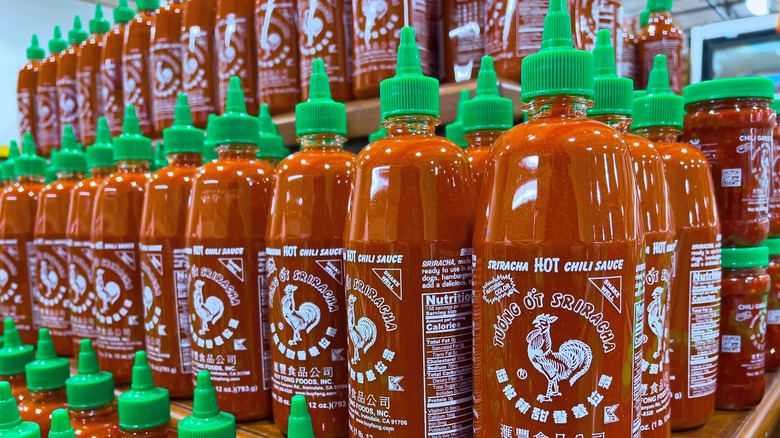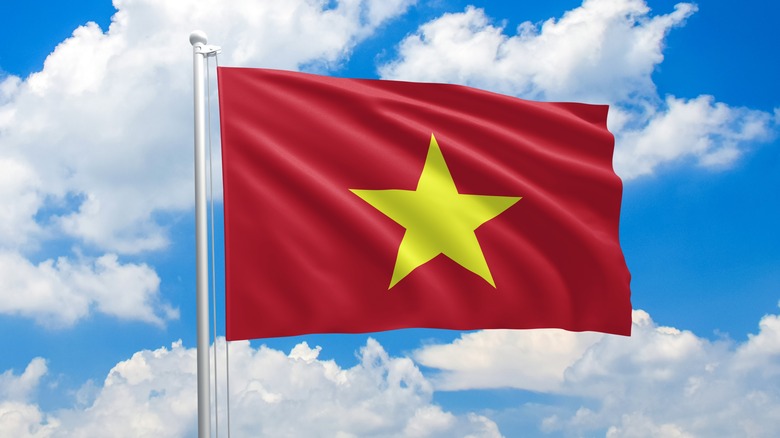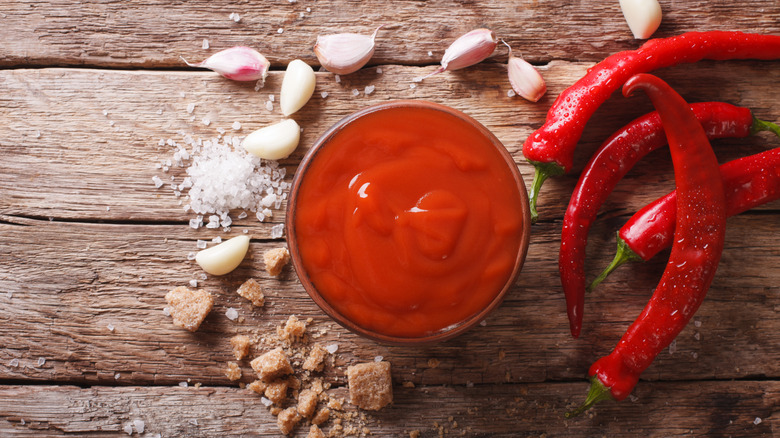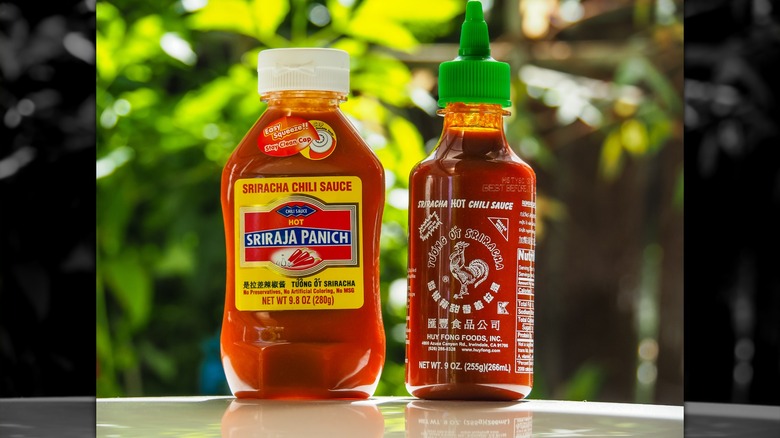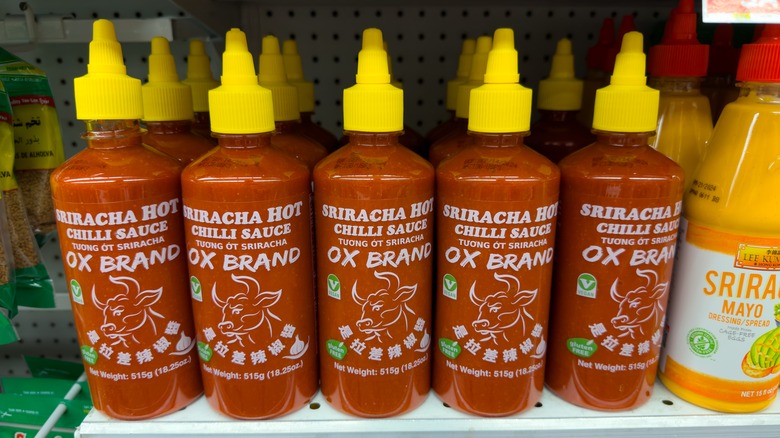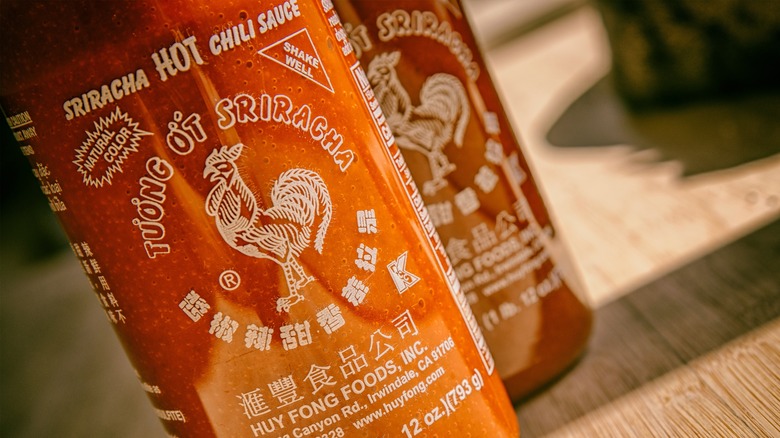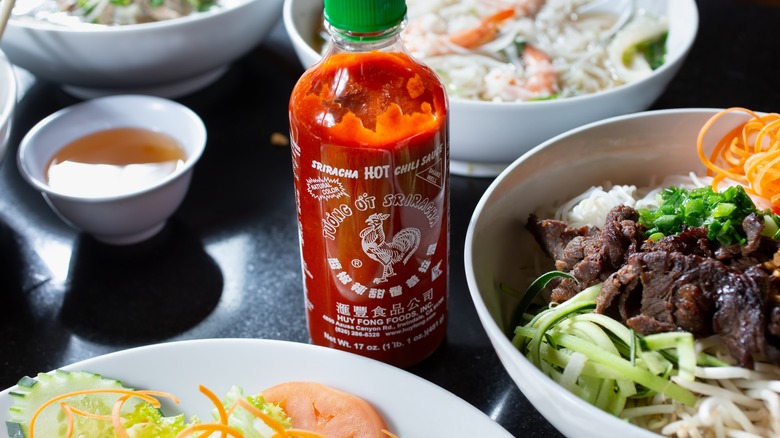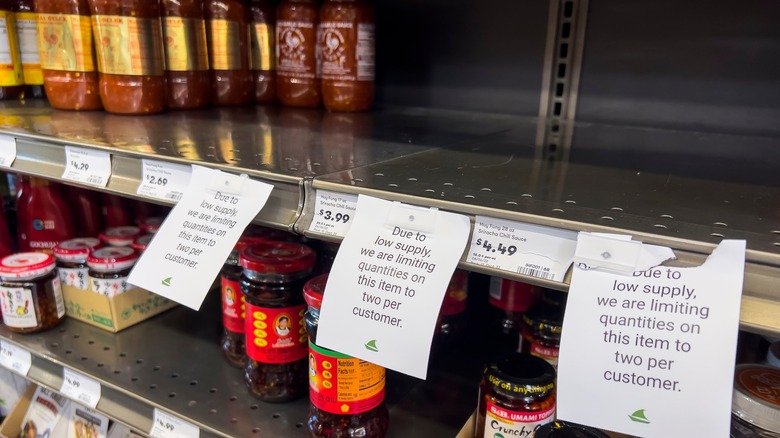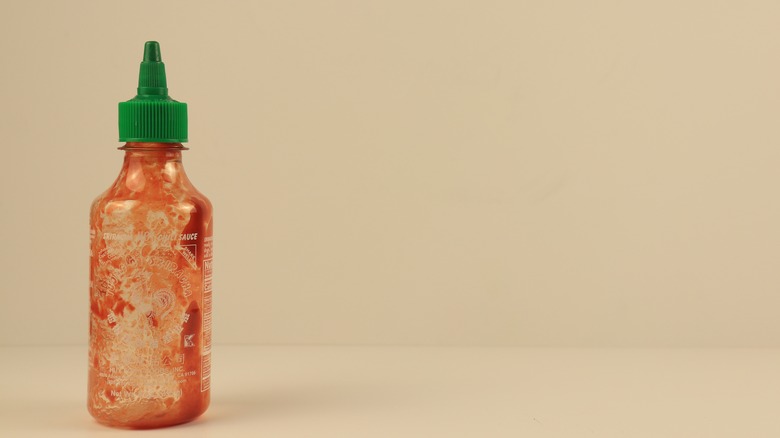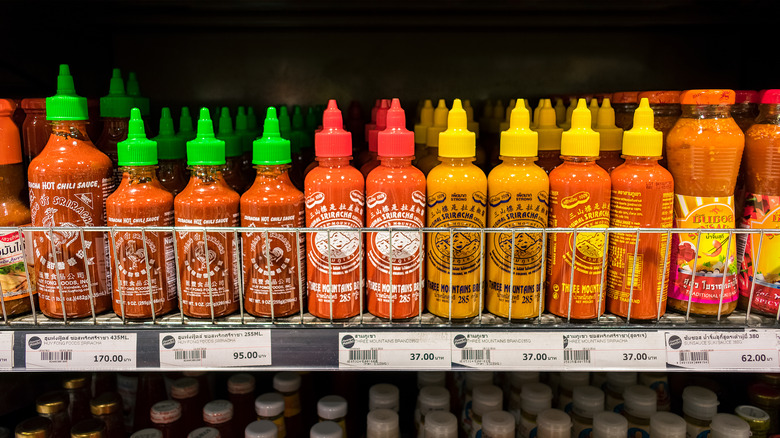10 Facts You Probably Didn't Know About Sriracha
Consisting of just a few basic ingredients — garlic, vinegar, sugar, salt, and chili peppers (the type varies depending on the brand) — sriracha sauce has gone from a local treat in Thailand to a widely popular condiment in countries around the world. But this spicy sauce has some surprises behind it. For instance, there are several different sriracha brands, but most of us are probably familiar with the Huy Fong company. This sauce has taken the world by storm, with an impressive 45% increase in sales from 2007 to 2021 in the U.S. alone.
Part of the reason for Huy Fong sriracha's success, and the popularity of sriracha in general, can be attributed to younger generations' interest in discovering global and fusion foods. But if you ask most of its fans, it comes down to sriracha's unique blend of flavors and the heat it brings to just about any food you can think of adding it to. In addition to smaller sriracha brands, big names like famous spicy sauce purveyor Tabasco have also gotten in on the trend, and it's no wonder why. Experts predict the market for sriracha will only grow in the coming years. But did you know that Huy Fong, the brand that made sriracha go global in the first place, may not survive to revel in that success? Whether you're a casual fan or totally spice-obsessed, here's more on that, plus nine more facts you probably don't know about sriracha.
Sriracha has ties to the Vietnam War
Though it was inspired by Asian cuisine and has its origins in Asia, Huy Fong Sriracha sauce is actually an American creation. The sauce, and company's, creator, David Tran, was born in Vietnam to a family with Cantonese ancestry. When the Vietnam War ended, the new government was unfriendly to Chinese immigrants, and so, in the late 1970's, Tran and his family left the country, eventually settling in California.
In Vietnam, Tran had begun to create his own hot sauce. Now, in the U.S., he started again. In 1980, he founded Huy Fong Foods, named for the boat that had brought him to America, and started selling his hot sauce out of a van. Soon, he'd made enough money to move into a factory and start producing his sauce, which he'd dubbed sriracha, on a much larger scale. By 2020, Huy Fong Foods was making an estimated $131 million in sales per year. Today, Huy Fong is estimated to be worth $1 billion. We may think of sriracha as simply a delicious spicy condiment, but behind it there's also the turmoil of war, the sting of prejudice, and an American dream come true — at least when it comes to Huy Fong's version of the sauce.
The sriracha you know isn't the original
Huy Fong Sriracha is the version most people know, but it's not the original sriracha sauce. That honor goes to a sauce called Sriraja Panich — at least as far as bottled, officially named sriracha sauces go.
Created in Thailand in the 1930's by home cook Thanom Chakkapak and her family, the sauce soon became popular among their friends. Chakkapak and other relatives began to bottle and sell the sauce, which Chakkapak named Sriraja Panich, after her native town of Si Racha. Today, the sauce is very popular in Thailand, although it's not as easy to find in other countries. But even this sauce has its predecessors. It's likely that Chakkapak's recipe was her own version of a spicy sauce brought to the region by Cantonese immigrants. Interestingly, all these sauces include chili pepper and garlic among their ingredients, but only Huy Fong's version has reached global popularity.
People from Si Racha don't like Huy Fong's sauce
As Huy Fong's sriracha sauce became more popular, people began looking into its origins and variants. In the 2010's, several reporters went to the town of Si Racha to see how its residents felt about Huy Fong's version, especially compared to Sriraja Panich, the original sriracha sauce. Both have similar base ingredients: hot peppers (goat peppers for Sriraja Panich and jalapeño chilis for Huy Fong), salt, sugar, garlic, and vinegar. But for many of Si Racha's residents, the end results are quite different.
Whether you read NPR's 2019 interview with the descendant of Sriraja Panich's creator or VOA correspondent Steve Herman's more neutral approach of interviewing residents of Si Racha with no known ties to either sauce, the general consensus among Si Racha's residents seems to be that while Huy Fong's sriracha sauce isn't horrible, it lacks the subtlety of hometown favorite Sriraja Panich. Huy Fong sriracha is a thicker sauce that brings heat to a dish, while the thinner Sriraja Panich is known for its subtle blend of hot, sweet, and sour notes. In recent years, Huy Fong has begun selling its sriracha in Thailand, but the brand differentiates itself from other sauces like Sriraja Panich. You'll often hear these referred to as Thai sriracha, while Huy Fong's version is considered American. Huy Fong founder David Tran even told The New York Times that his brand is "not a Thai sriracha. It's my sriracha."
Sriracha isn't a registered trademark
For many people around the world, sriracha is synonymous with Huy Fong's spicy sauce. But because there are similar sauces that came before it, including Sriraja Panich, it probably wouldn't have been easy or even possible to trademark the name Si Racha (which is also a town) or sriracha. In fact, authorities like the U.S. Patent and Trademark Office consider sriracha a generic term. Still, Huy Fong Foods founder David Tran could have tried to trademark his sauce's name, as some competitors have attempted to do. The fact that he didn't is something intellectual property lawyer Jonathan Smig finds "fascinating". Trademarking could be seen as a disadvantage as other companies that want to use the name sriracha can — and do, including Huy Fong's current major rival, Tabasco. But Tran sees it instead as free advertising. Smig agrees: "Everyone else uses the term 'sriracha,' but most of the public still identifies the term with his company's product."
Tran didn't totally forego trademarks, though. Both sriracha's bottle cap design and its rooster logo (inspired by the Chinese zodiac year of Tran's birth and roosters being a symbol of strength in Vietnamese culture) are trademarked. Still, if you're not extremely familiar with the exact look of Huy Fong sriracha's logo and bottle, there are some very convincing copycats out there. So, if you want the real Huy Fong sriracha sauce, make sure to look for the company's name on the bottle.
Huy Fong does no advertising for its sriracha sauce
Think of a Huy Fong sriracha ad. If you can't, there's a reason: Huy Fong doesn't advertise. They also have a shockingly simple, no frills website, and they don't do social media. There seem to be two main reasons for this. Firstly, Tran worries that advertising would make even more people aware of his best-selling product, making it even harder to meet customer demand.
The second reason why Huy Fong doesn't advertise comes down to Tran's very non-commercial outlook on life and business. Not only does he think not having a trademarked name means free advertising; he's even suggested that consumers "make your own" sriracha sauce like his if they want to. Speaking to Quartz, Tran explained that his dream is "to make enough fresh chili sauce so that everyone who wants Huy Fong can have it. Nothing more."
When you consider this, it's even more impressive that Huy Fong Sriracha is the most famous brand out there and remains high in sales rankings, despite shortages and serious competition. Speaking of competition, even without advertising, when it comes to brand loyalty, Huy Fong Sriracha has others beat. As marketing expert Laurel Collins puts it, "Huy Fong Foods sriracha has the kind of consumer loyalty that the CPG conglomerates spend hundreds of millions of marketing dollars annually to try, and usually fail, to obtain."
Sriracha is in recipes around the world
Sriracha may have its origins in China and Thailand, but the sauce has found fans around the world. Sriracha sauces, including the original sriracha sauce brand, Sriraja Panich, have been a part of several world cuisines for years. For instance, in its native Thailand, Sriraja Panich is often used as a dipping sauce for seafood or served with omelets. In Vietnamese cuisine, many people add sriracha to pho. Huy Fong Foods founder David Tran told the New York Times that he created his version of the sauce when he came to the U.S. in part because he "knew, after the Vietnamese resettled here, that they would want their hot sauce for their pho".
Huy Fong sriracha's popularity made the sauce go global and is used as a seasoning for everything from ramen noodles to hamburgers. Some fans even like to pair it with potato chips. (Doritos took the work out of that, with their Screamin' Sriracha flavor.) In addition to fun snack experiments, sriracha has also become an essential ingredient for sushi restaurants. Sriracha documentarian Griffin Hammond found that sriracha is the ingredient used in most spicy tuna rolls in U.S. sushi restaurants, and estimates that these restaurants must be a big part of Huy Fong and other sriracha brands' customer base.
Huy Fong's sriracha plant was once declared a public nuisance
Huy Fong Sriracha is delicious on or in countless foods, it turns out it's not so great when it's in the very air you breathe. That's what residents of Irwindale, California, learned firsthand. In 2013, many of them began to notice a spicy, garlicky smell in the area near the Huy Fong Sriracha plant. Some residents said it made their eyes tear and made it difficult to breathe. One man who lived near the plant claimed he even had to bring his children inside whenever the smell got too strong.
The city took action and Huy Fong ultimately found itself threatened with having to close its plant. Fortunately, things worked out. Authorities said the smell couldn't be proven as the source of residents' irritated eyes and breathing, although they did consider the plant a public nuisance due to the strong odor emanating from it at times. Huy Fong installed a new system to filter the fumes, which were especially strong during months when the sauce's chilis were being ground.
Sriracha shortages were due to weather and a lawsuit
As fans of the brand know, there have been several Huy Fong Sriracha shortages over the past few years. This is often explained by bad chili pepper harvests or a lack of chili peppers due to weather conditions. But there's more to the story. For 28 years, Huy Fong had a partnership with Underwood Farms, which was the exclusive provider of all of the brand's jalapeño chili peppers. Then, in 2017, Huy Fong accused Underwood of overcharging them in 2016, and took them to court. Underwood Ranches owner Craig Underwood countersued. In the end, both sides had to pay sums in the millions of dollars to one another, but worst of all, for Huy Fong at least, the relationship between the two companies was severed.
Since 2017, Huy Fong has been getting its chiles from other farms in California, as well as Mexico and New Mexico. That's where the weather conditions come in. Droughts have caused chili harvests to dwindle, and Huy Fong hasn't been able to make enough sauce. Meanwhile, Underwood reports that his crops have been going strong, something his new clients must appreciate ... and something that might make Huy Fong founder David Tran regret cutting ties with his former chili pepper source.
Huy Fong sriracha is losing its popularity and maybe its taste
Despite being a leader in the brand recognition department, Huy Fong sriracha isn't doing as well as you'd think when it comes to sales. A January 2024 report published on PennLive reveals that while Huy Fong was listed as the most requested hot sauce on Instacart in 2022, its sales figures have since decreased dramatically. The reason, you might guess, is because of the recent Huy Fong Sriracha shortages. Unable to purchase the sauce made by their favorite brand, many Huy Fong Sriracha fans are choosing (or settling for) other kinds of hot sauce instead, including the site's top seller Frank's Hot Sauce. That said, the site reports that Huy Fong Sriracha still ranked at number 8 in sales, despite the shortage.
Fortune recently shared data showing that Tabasco's sriracha was the bestselling one in the U.S. from June to December, 2023. Another Huy Fong sriracha shortage, announced in May 2024 and projected to last until September 2024, means the brand's bestseller status continues to be in peril. Huy Fong sriracha's taste may also impact its sales. Sriracha aficionados have noticed that in recent years, the sauce doesn't always pack as much heat as they've come to expect. Ever since that lawsuit and separation from chili supplier Underwood Ranches, Huy Fong has had to source their peppers from a number of different farmers, leading to spiciness and quality that isn't always the same.
Other sriracha brands may rise to fame
Since sriracha is not a trademarked name, there are many companies that make their own version of it, sticking closely, for the most part, to that simple but delicious combination of chilis, vinegar, garlic, salt, and sugar. Of course, each brand has its particular techniques and blend. For instance, Huy Fong Sriracha is made only using fresh chilis, as opposed to dried peppers, which are easier to store and work with.
Sriracha fans notice differences between brands and often have their favorite. But those who prefer Huy Fong Sriracha may be getting their spicy sauce fix elsewhere while Huy Fong battles supply shortages. One favorite for many is Shark brand sriracha, which is a Thai-style sriracha. Some major brands have also gotten into the sriracha game. Tabasco has been a particularly ruthless (and successful) competitor. In fact, the brand bought the domain name www.srirachashortage.com, whose landing page features the question "Looking for something?" and ultimately leads visitors to an image of Tabasco's own sriracha sauce bottle. Hopefully, Huy Fong sriracha fans won't have to go without their favorite for long ... but in the meantime, they may find another sriracha sauce to fall in love with.
